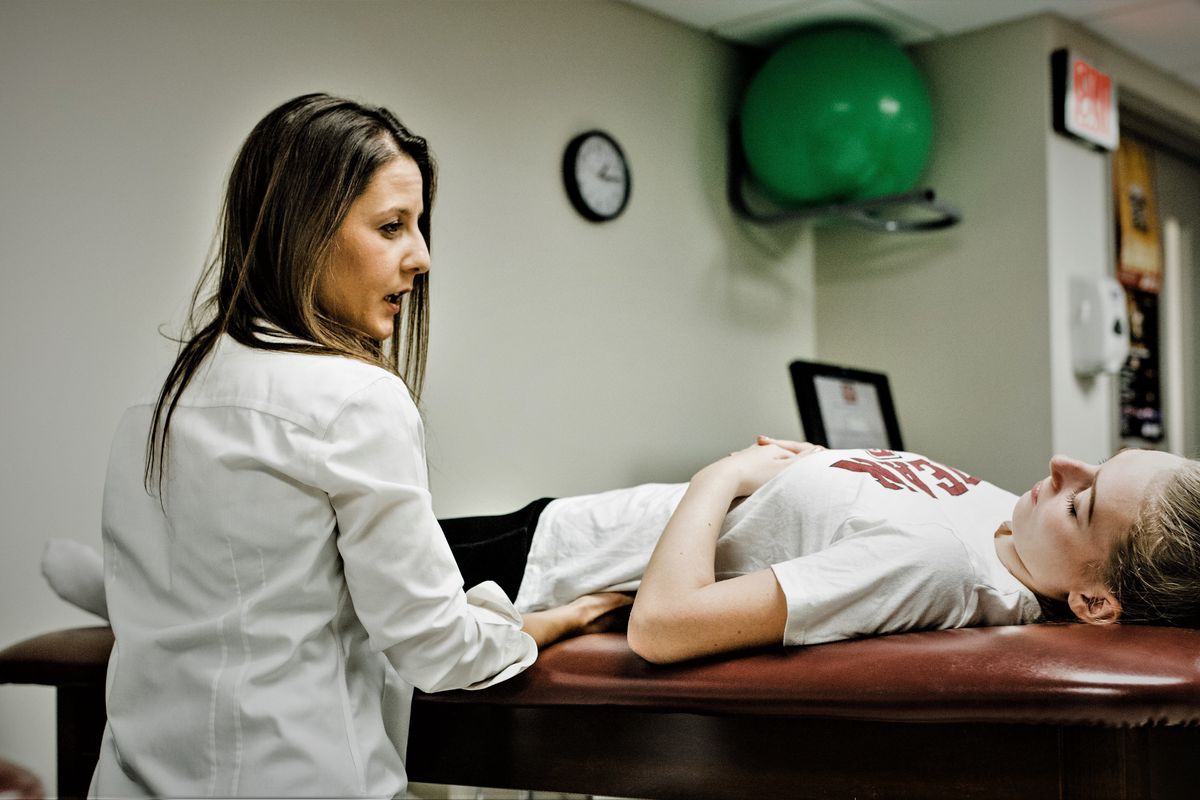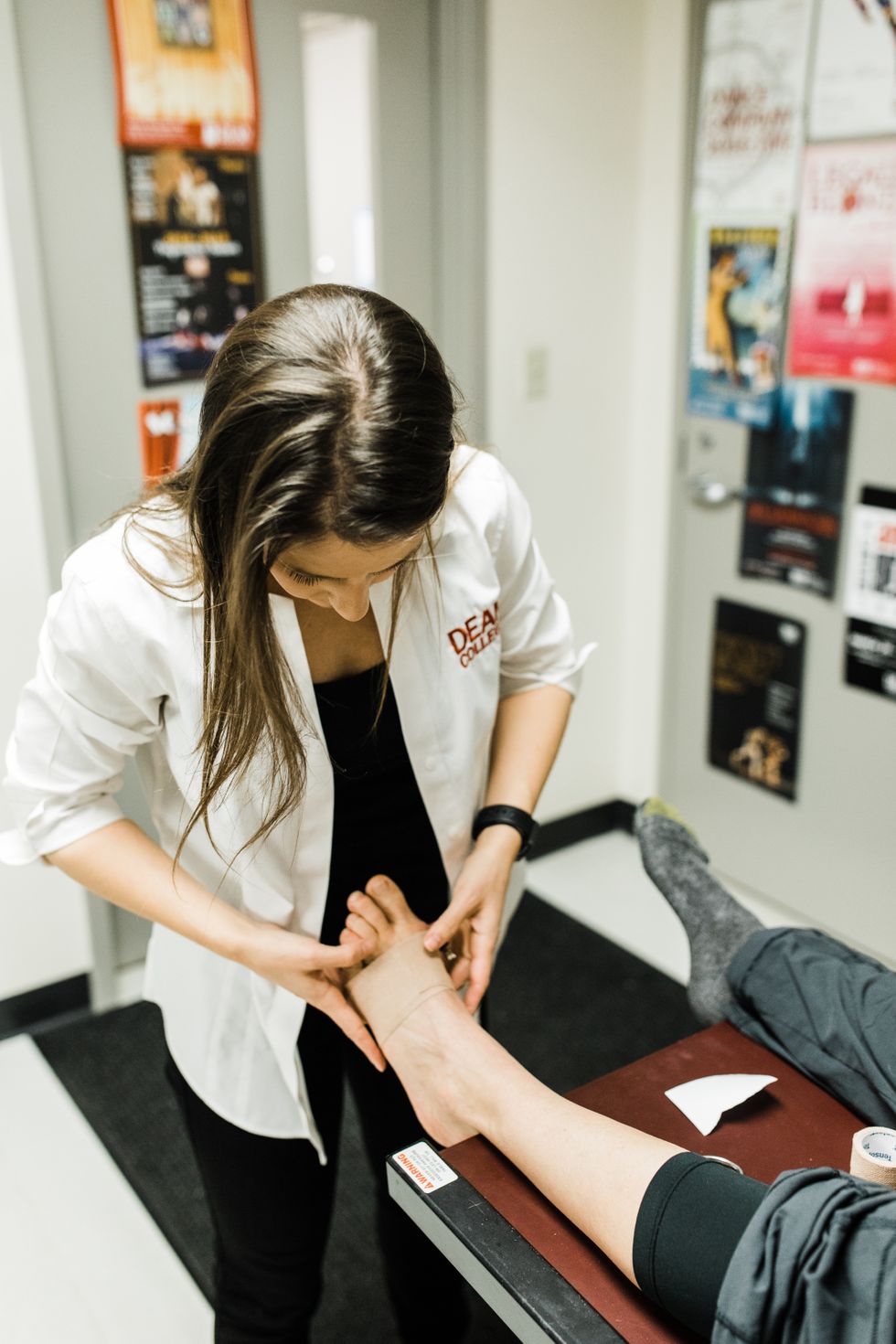
The Joan Phelps Palladino School of Dance at Dean College is one of just 10 college programs in the U.S. with a full-time athletic trainer devoted solely to its dancers. But what makes the school even more unique is that certified athletic trainer Amanda Donahue isn’t just available to the students for appointments and backstage coverage—she’s in the studio with them and collaborating with dance faculty to prevent injuries and build stronger dancers.
“Gone are the days when people would say, ‘Don’t go to the gym, you’ll bulk up,'” says Kristina Berger, who teaches Horton and Hawkins technique as an assistant professor of dance. “We understand now that cross-training is actually vital, and how we’ve embraced that at Dean is extremely rare. For one thing, we’re not sharing an athletic trainer with the football players, who require a totally different skillset.” For another, she says, the faculty and Donahue are focused on giving students tools to prolong their careers.
After six years of this approach, here are the benefits they’ve seen:

Dean College students in “Albedo Rondo” by professor Kristina Berger
Scott May, Courtesy Dean College
Performance Enhancement and Injury Reduction
“Normally, an athletic trainer in the collegiate dance setting would be in the athletic training clinic, where students could schedule an appointment for an injury evaluation or prevention assessment, or backstage during a performance run, where I manage acute injuries and emergency care,” says Donahue. “But because I’m also in the classroom, I have the opportunity to see and understand exactly what their daily physical demands are.” In the studio, she talks to dancers about the anatomy involved in executing a movement efficiently and equips them with exercises or warm-ups. Sometimes she helps to choreograph where students should inhale and exhale throughout the movement, and helps encourage a greater use of their core.
“Ours is a triple-track program in which students intensively study ballet, modern and jazz techniques, in addition to a number of related dance forms,” says Marc Arentsen, dean of the Palladino School of Dance. “In a biomechanical sense, our dancers are not unlike elite athletes and we recognized that advanced dance training and injury prevention should go hand in hand. Now the integration of athletic training strategies with the outstanding technical preparation our dancers receive has become part of our culture.”
Since Donahue joined the Dean College dance community as a full-time dedicated athletic trainer six years ago, the total percentage of students who sustain an injury each year has decreased from 65 percent to 35 percent. “When students understand what muscles they should be engaging and the basic biomechanics of the movement, it enhances their performance, too,” says Donahue.

Donahue teaches a student how to apply athletic tape.
Courtesy Dean College
Better Communication Between Teachers and Athletic Trainers
“Having the ability to work with and not only for the dance faculty is really unique for an athletic trainer,” says Donahue. “And I learn just as much from them as they do from me.” She says watching the teachers give students external physical cues for movement or noting what warm-ups they use gives her information she can incorporate into rehab sessions. “I can say, ‘Remember how you did this in class? Let’s go back to where you’re initiating that movement,’ ” says Donahue.
From working side by side with an athletic trainer, Berger has come to realize how much of Horton technique already incorporates cross-training. “Going from stag position to lateral T actually helps develop hip stabilization, and all the deep floor vocabulary can be directly connected to a lot of what you see in yoga, Pilates or strength training,” she says. “Amanda will give the students an exercise and I think, ‘That’s just like Horton.’ ”

Kristina Berger infuses her Horton technique class with athletic training strategies.
Courtesy Dean College
More Fluent Dancers
Donahue says Dean students have a greater understanding of healthy warm-up techniques, the importance of cross-training and how to manage injuries. “They start to use the same language I use to describe exactly where their pain is. They’ll say, ‘It hurts more in the peroneal tendon,’ instead of, ‘It hurts on the outside of my leg.’ This especially helps if they’re off-campus and seeing a doctor who doesn’t normally treat dancers,” she says.

Courtesy Dean College
Ability to Personalize Training
Dean guides students through a process of addressing their strengths and weaknesses, which might be something dancers are left to figure out on their own at other schools. “They might be coming from a studio where, unfortunately, no one taught them how to support something as simple as standing on one leg,” she says. But, from day one at Dean, dancers have a one-on-one evaluation with Donahue, who helps them set up a training program based on their history, what injuries they might have right now and what they’re struggling with in class. “I’m also given that information so I can try to address what I can in the studio,” says Berger. “I can’t formulate the class around one dancer, but everyone can benefit from some corrections that address an issue several students are working on.”

Courtesy Dean College
Graduates with a Career Edge
Berger believes that students leave Dean with the ability to set up their own training program tailored to what they’ll face in the working world. “If they book a job on a cruise ship that’s three shows a day, they have the tools to figure out that’s X amount of leaps in each show and here’s how I can prepare for that,” she says. “These dancers know not only how to manage their time but also their bodies, even early in their careers.”



